ISSN
2307–3489 (Print), ІSSN
2307–6666
(Online)
Наука та
прогрес транспорту. Вісник
Дніпропетровського
національного
університету залізничного
транспорту, 2018, №
3 (75)
ЗАЛІЗНИЧНА
КОЛІЯ
заЛІЗНИЧНА КОЛІЯ
UDC
625.141-047.37
S. FISCHER1*,
A. NEMETH2*,
D. HARRACH3*,
E. JUHASZ4*
1*Dep.
«Transport Infrastructure», Szechenyi
Istvan University, Egyetem
Sq., 1, Gyor,
Hungary, 9026, tel. +
36 (96) 613 544,
e-mail
fischersz@sze.hu,
ORCID 0000-0001-7298-9960
2Dep.
«Transport Infrastructure», Szechenyi
Istvan University, Egyetem
Sq., 1, Gyor,
Hungary, 9026, tel. +
36 (96) 613 544,
e-mail
nemeth.attila@sze.hu,
ORCID 0000-0002-3477-6902
3*Dep.«Structural
and Geotechnical Engineering», Szechenyi
Istvan University, Egyetem
Sq., 1, Gyor,
Hungary, 9026,
tel. +
36 (96) 613 541, e-mail
harrach.daniel@sze.hu,
ORCID 0000-0003-4819-8506
4*Dep.«Transport
Infrastructure», Szechenyi
Istvan University, Egyetem
Sq., 1, Gyor,
Hungary, 9026, tel. +
36 (96) 613 544,
e-mail
era__juhasz@hotmail.com,
ORCID 0000-0002-5544-3146
Specific Assessment method of RAILWAY BALLAST
particle DEGRADATION BASED ON unique LABORATORY TEST
Purpose. There are specific, standardized laboratory test
methods to assess railway ballast particle degradation; they are the
Los Angeles (EN 1097-2) and the Micro-Deval abrasion (EN 1097-1)
tests. These testing methods can’t take into consideration the real
railway stress-strain circumstances of ballast materials, and they
particles. In this paper the authors represent a specific laboratory
fatigue breakage test of railway ballast materials. With this kind of
testing method, the deterioration process of railway ballast
particles can be assessed more realistic and precisely. Methodology.
A special layer structure is built-up with elastic sublayer system
and 30 cm thick ballast samples (from two different type andesite
base rocks) that is loaded by dynamic, pulsating forces. Particle
size distribution functions have to be recorded before and after a
more million cycle fatigue test, but intermediate measurements are
also executed. The measured data should be processed, and different
parameters have to be calculated that are offered by international
literature and researches. The test doesn’t consider the particle
breakage due to hand-made and machine-made tamping, but it can
simulate particle degradation due to more years’ railway traffic in
laboratory circumstances.
Findings.
There is a development after the R&D work made and published in
2014: in 2017 and 2018 years the ballast particle deterioration
process is given according to more intermediate fatigue cycles with
individual measurements, that show more precise «picture» about the
full particle degradation, i.e. breakage process. The authors give
more precise correlation functions between the calculated parameters
and load cycles during fatigue. Originality. The paper summed
up the results of a specific developed laboratory test method for
assessment of the breakage process of railway ballast particles
according to two different railway ballast materials from andesite
base rocks. Practical value. The
results help with the calculation of approximate time interval of
required ballast screening (cleaning) work in the future. This
research is supported by the ÚNKP-17-4 New National Excellence
Program of Ministry of Human Capacities.
Keywords: railway ballast material; particle degradation &
breakage; specific laboratory test method; dynamic fatigue test
Purpose
In the EU’s 2014-2020 Finance
Programme Hungarian railway construction and rehabilitation projects
can be financed by more than thousand billion Hungarian Forints,
from which quantity of money important railway projects can be
executed. The important part of these projects is the ballast that
is the most component of superstructure. In nowadays practice it is
obvious aspect that required quality ballast [3, 5, 13-22] is
achievable in requested quantity.
In the followings the authors
point to those criteria because of that the future view is more
shaded, and which are prescribed that special rock physics tests
(Los Angeles and Micro-Deval abrasion tests) are highly suggested
with more real loading conditions than the standardised tests
considering available stone-rock qualities’ limits.
The grains’
original – base rock-dependent – abrasion properties can be
hardly modified by technology methods, these are mostly depending on
«aggregate asset» and rocks’ mechanical characteristics. In
professional events more and more presentations are made about the
fact that environmental, nature-reservational, heritage-protective,
etc. regulations hitting the stone-mining industry aggravated year
by year generally mean such restrictions [13, 14] on the access of
the natural wealth that might lead to problems in base material
supply and increasing quality hazard on the medium term.
The authors think it a base
problem that the ability for railway ballast material is
internationally required the Los Angeles abrasion and Micro-Deval
abrasion tests [15, 16] in the product standard [17]. These
laboratory tests are not able to simulate the real evolved stresses
of railway ballast (it should be mentioned that in case of e.g.
asphalt and concrete road pavements’ «stone skeleton» [1, 10,
11] these laboratory tests are not the optimal solution, either).
For the objective judgement of conformability special laboratory
breakage test has to be used that consider the more real operation
circumstances and stresses.
After the
international literature review, the authors represent the own,
unique solution for a special laboratory test procedure (method)
that is able to simulate the stresses more realistic. The results
are comparable to the conventional, standardised abrasion
(degradation) tests [15, 16], the degradation qualifying parameters
used internationally [8, 9, 12], as well as required cycle of
ballast cleaning work [2, 12].
Methodology
In 2014 an R&D was made
with the finance support of Colas Északkő Ltd.; the public
information were published in [6, 7]. Below these results are
shortly detailed:
– there
is no strong correlation between any degradation parameters and
their change, as well as the measured and calculated rock mechanic
parameters. This result wasn’t unexpected because of the base
assembly of laboratory tests (rotating steel drum filled with
ballast particles with or without steel balls vs. a «box» filled
with ballast, pulsated by dynamic cyclic force),
– in
the article [4] the particle degradation due to tamping technology
was examined in the laboratory, the authors of this paper weren’t
able to verify neither physical nor mathematical correlation between
the Los Angeles abrasion value of the samples and the particles
shape parameters,
– the
time interval values of ballast cleaning-screening work were
determined according to earlier experience data of MÁV (Hungarian
Railways) and international literature [2, 12].
The authors have supplementary
plans compared to the research executed in 2014: more accurate
measurement of the variation of ballast grains’ degradation as a
function of pulsating cycles (or elapsed time during the fatigue
test) with the manner detailed below:
– testing
of minimum two types of ballast samples with different rock mechanic
properties (ballast samples from Colas Északkő Ltd.),
ballast
sample #1: LARB=19%,
MDERB=17%,
ballast
sample #2: LARB=16%,
MDERB=4%,
– fatigue
tests connected to railway ballast material samples, definition of
PSD (particle size distribution) before and after fatigue tests with
the following load cycles: 0.1 million; 0.2 million; 0.5 million; 1
million and 1.5 million; 3 million and 5 million (the authors
modified the initial plan and they will execute measurements with
maximum 5 million cycles, but in this way they don’t have the
opportunity to make measurements with 3 separate measures),
– separate
ballast sample should be for each fatigue test, i.e. the test series
will be like the following:
ballast sample should be
cleaned and washed (the particles more than 22.4 mm are needed for
the tests),
PSD should
be determined (BP – before pulsating test),
0.1 million loading cycles
should be utilized,
PSD should be determined (AP –
after pulsating test),
the ballast sample has to be
thrown away,
another (new) ballast sample
should be cleaned and washed (the grains more than 22.4 mm are
needed for tests),
PSD should
be measured (BP – before pulsating test),
0.2 million loading cycles
should be used,
PSD should be determined (AP –
after pulsating test),
the ballast sample has to be
thrown away,
etc. until 5 million loading
cycles.
– FV
[12], BBI [9] parameters have to be determined,
– grain
quantity d<22.4 mm, d<0.5 mm, d<0.063 mm, the ratio
d60/d10,
moreover M and
[8] parameters should be defined,
– the
goal is to effort determine mathematical-physical trends and
correlation between characteristics (see above point) and loading
cycles of fatigue test.
The noticed
measurements are also performed using of fresh railway ballast
samples from andesite base rocks, as these measurements were
executed in the research in 2014. The dynamic fatigue test series
were able to be begun in March, 2018, the full results is able to be
published in June, 2018.
Findings
In this paper the authors are
able to sentence the results until 3 million loading cycles, because
the measurements with fatigue tests are done as follows:
– ballast
sample No. 1: 0.1 million; 0.2 million; 0.5 million, 1.5 million and
3 million;
– ballast
sample No. 1: 0.1 million; 0.2 million; 0.5 million, 1 million and 3
million.
Fig. 1–8
represent the calculated parameters as a function of number of
loading cycles (all the particle size distribution functions are not
published because of the limited content only the calculated
parameters that can be calculated from that).
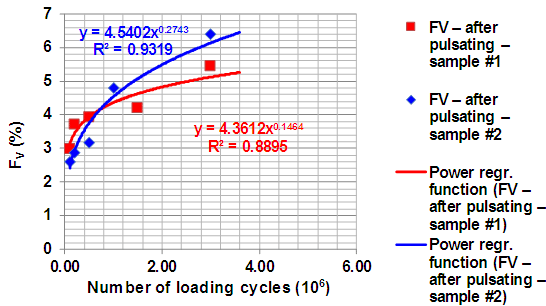
Fig. 1. Function of parameter FV (%)
as a function of
number of loading cycles related
to both ballast samples
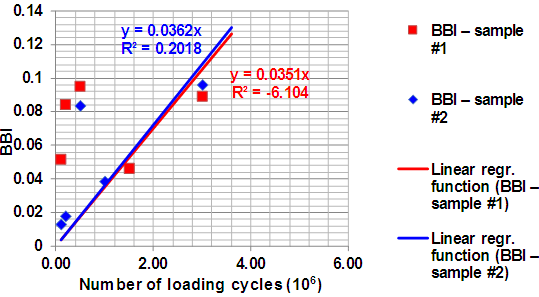
Fig. 2. Function of parameter BBI as a function
of number of
loading cycles related
to both ballast samples
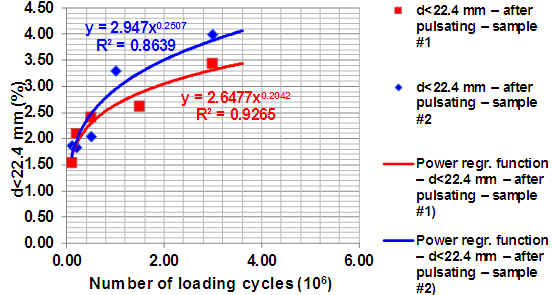
Fig. 3. Function of parameter d<22.4 mm (%)
as a function of
number of loading cycles related
to both ballast samples
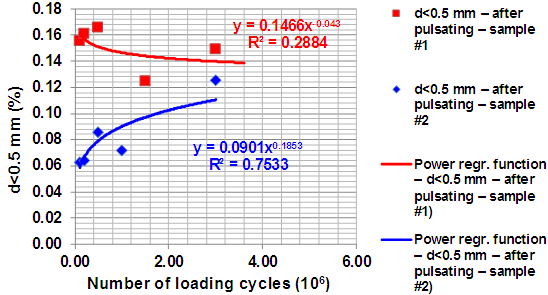
Fig. 4. Function of parameter d<0.5 mm (%)
as a function of
number of loading cycles related
to both ballast samples
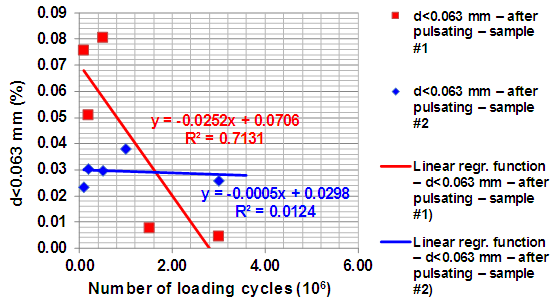
Fig. 5. Function of parameter d<0.063 mm (%)
as a function of
number of loading cycles related
to both ballast samples
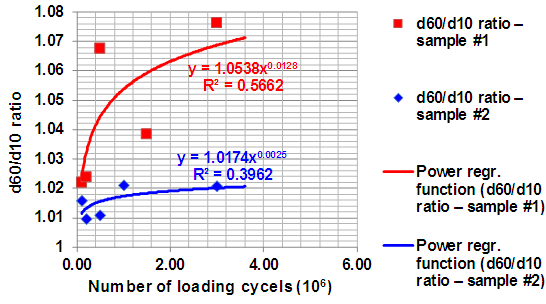
Fig. 6. Function of parameter d60/d10 ratio
as a function of number of loading cycles related
to both
ballast samples
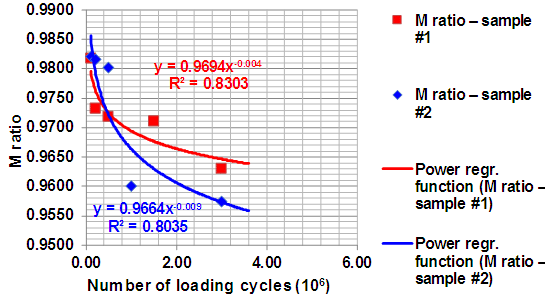
Fig. 7. Function of parameter M ratio
as a function of number of
loading cycles related
to both ballast samples
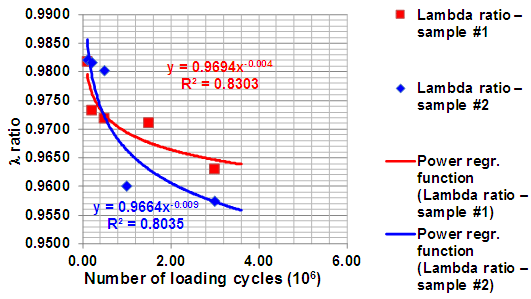
Fig. 8. Function of parameter
ratio
as a function of number of loading cycles related
to
both ballast samples
Originality and practical
value
According to the Fig. 1-8 the
following results can be determined, that are not the final results
of the research, and they consider the maximum 3-million-fatigue
cycles (not the 5 million):
– there
are significant correlation (R2>0.8)
related to four calculated parameters from the eight (as a function
of number of loading cycles), the regression functions are power
regression function:
FV,
i.e. the parameter that can forecast the necessity of ballast bed
screening, this parameter is recommended by the South African
Railways [12],
d<22.4 mm (in mass percent)
related to after pulsating,
M and
parameters [8] that are recommended by researchers from the BME
(Budapest University of Technology and Economics) (now the authors
used the M and
ratios: the ratio of numbers after pulsating and before pulsating,
respectively).
– The
regressions are not significant (neither with linear, nor with power
regression functions) related to the other four calculated
parameters,
– in
detailed analysis (considering only the significant correlations)
the authors can highlight the fact, that «speed» of the breakage
(the tangent of the functions) is higher related to ballast sample
#2 than ballast sample #1, that is very interesting because both the
LARB
and MDERB
parameters are better (lower) for ballast sample #2,
– to
be able to sentence final results the missing measurements are
needed (i.e. the measurements until dynamic fatigue with 5 million
loading cycles).
Conclusions
This article
introduces a research’s results (but not the final results)
supported by ÚNKP-17-4 New National Excellence Program of Ministry
of Human Capacities. The accurate topic in the ÚNKP project is the
«Innovative breakage test method of railway ballast material». In
the authors’ earlier paper the up-to-date international research
achievements were resulted related to conventional (standardized)
and non-conventional (non-standardized), additionally seperate
laboratory breakage and abrasion test methods and DEM simulations of
ballast materials. The research plan was introduced and detailed for
2017 and 2018 years, it can be scored as the enhancement of the
earlier research. The authors sentenced the results of the
laboratory tests in the consideration of the maximal 3 million
fatigue cycles for the two different andesite railway ballast
samples. The developed method seems to be adequate for evaluating of
the degradtion process of railway ballast material according to
railway.
Acknowledgements
This paper is supported by the
ÚNKP-17-4 New National Excellence Program of Ministry of Human
Capacities.
List of reference links
Ambrus,
K. Útépítési zúzottkövek és zúzottkavicsok aszfaltkeverékek
gyártásához, felületi bevonatok készítéséhez [Electronic
resource] / К. Ambrus, І.
Pallós. – 2012. – Available at:
http://docplayer.hu/9502775-Utepitesi-zuzottkovek-es-zuzottkavicsok-aszfaltkeverekek-gyartasahoz-feluleti-bevonatok-keszitesehez.html
– Title from the screen. – Accessed : 11.06.2018.
Arangie, P. B. D. The influence
of ballast fouling on the resilient behaviour of the ballast
pavement layer // Proc. of 6th Intern. Heavy Haul Railway Conf.
(Cape Town, 1997, April 6–10). – Cape Town, 1997. – Р.
241–256.
Claisse, P. Rail ballast:
conclusions from a historical perspective / P. Claisse, C. Calla //
Proceedings of the Institution of Civil Engineers – Transport. –
2006. – Vol. 159. – Іss. 2. – P. 69–74.
doi:
10.1680/tran.2006.159.2.69
Douglas,
S. C. Ballast Quality and
Breakdown during Tamping /
S. Caleb Douglas
// 2013 Joint Rail Conference:
Conf. Paper (Knoxville, Tennessee, USA, April 15–18, 2013). –
2013.
doi:
10.1115/JRC2013-2553
DB. «TL DBS 918 061: Technische
Lieferbedingungen Gleisschotter» (TL DBS 918 061: Technical
delivery conditions Railway ballast). – Berlin, 2006/08.
Fischer,
Sz. A
vasúti
zúzottkövek
aprózódásvizsgálata
egyedi
laboratóriumi
módszerrel
/ Sz. Fischer
// Sínek Világa. – 2015. – Vol. 57, No.
3. – P. 12–19.
Fischer,
Sz. Breakage Test of Railway Ballast Materials with New Laboratory
Method / Szabolcs Fischer // Periodica Polytechnica Civil
Engineering. – 2017. – Vol. 61, No.
4. – P. 794–802. doi: 10.3311/PPci.8549
Gálos,
M. Ágyazati kőanyagok: A kutatás eredményei. 2 rész. / М.
Gálos, L. Kárpáti, D. Szekeres // Sínek Világa. – 2011. –
Vol. 55, No. 1.
– P. 6–13.
Indraratna, B. Advanced rail
geotechnology – Ballasted track / Buddhima Indraratna, Wadud
Salim, Cholachat Rujikiatkamjorn. – London : CRC Press, 2011. –
432 р.
Kausay,
T. Adalékanyagok kőzetfizikai tulajdonságai. Út- és hídépítési
műszaki előírások és alkalmazási tapasztalataik [Electronic
resource] / Т. Kausay. – Budapest,
2011. – Available at:
http://www.betonopus.hu/szakmernoki/kozut-2-adalekanyag-kozetfizika.pdf
– Title from the screen. – Accessed : 11.06.2018.
Kausay,
T. Zúzott betonadalékanyagok kőzetfizikai tulajdonságai a
szabályozásban / Т. Kausay // Mérnökgeológia Kőzetmechanika
2008. – Budapest, 2008. – Р. 259–270.
Lichtberger,
B. Track compendium:
Formation, Permanent Way, Maintenance,
Economics / В.
Lichtberger. –
Hamburg :
Eurailpress Tetzlaff-Hestra GmbH & Co,
2005. – 634 р.
MÁV.
«A 102345/1995 PHMSZ előírás 3. számú módosítása»
(Modification 3 in MÁV 102345/1995 PHMSZ. Railway substructure and
ballast quality acceptance regulations instruction). – Budapest,
2008. – 5 р.
MÁV.
«A 102345/1995 PHMSZ előírás 4. számú módosítása».
(Modification 4 in MÁV 102345/1995 PHMSZ. Railway substructure and
ballast quality acceptance regulations instruction). – Budapest,
2010. – 14 р.
MSZ EN 1097-1:2012.
«Kőanyaghalmazok mechanikai és fizikai tulajdonságainak
vizsgálata. 1. rész: A kopásállóság vizsgálata
(mikro-Deval)». (Tests for mechanical and physical properties of
aggregates. Determination of the resistance to wear (micro-Deval).
– Budapest, 2012. – 35 р.
MSZ EN 1097-2:2010.
«Kőanyaghalmazok mechanikai és fizikai tulajdonságainak
vizsgálata. 2. rész: Az aprózódással szembeni ellenállás
meghatározása». (Tests for mechanical and physical properties of
aggregates. Methods for the determination of resistance to
fragmentation). – Budapest, 2010. – 35 р.
MSZ EN 13450:2003.
«Kőanyaghalmazok vasúti ágyazathoz». (Aggregates for railway
ballast). – Budapest, 2003. – 33 р.
MSZ EN 1367-2: Kőanyaghalmazok
termikus tulajdonságainak és időjárás-állóságának
vizsgálati módszerei. 2. rész: Magnézium-szulfátos eljárás.
– Budapest, 2010. – 16 р.
MSZ
EN 933-3: Kőanyaghalmazok geometriai tulajdonságainak vizsgálata.
3. rész: A szemalak meghatározása. Lemezességi szám. –
Budapest, 2012. – 12 р.
Paiva, C. E. L. Study of Railway
Ballast Fouling by Abrasion-Originated Particles / Cassio E. L. de
Paiva, Mauro L. Pereira, Lia L. Pimentel // Railway Engineering –
2017 : Proc. of the 14th Intern. Conf. (Edinburgh, Scotland, UK,
21st–22nd June 2017). – Edinburgh, 2017.
Sadeghi, J. M. Developing Track
Ballast Characteristic Guideline In Order To Evaluate Its
Performanc / J. M. Sadeghi, J. Ali Zakeri, M. Emad Motieyan
Najar // International Journal of Railway. – 2016. – Vol. 9. –
Іss. 2. – P. 27–35. doi: 10.7782/IJR.2016.9.2.027
Track
ballast in Austria: Parts 1, 2, 3 [Electronic resource]. –
P. 1–11. – Available at:
https://www.plassertheurer.com/fileadmin/user_upload/Mediathek/Publikationen/ri_12888990.pdf.
– Title from the screen. – Accessed :
14.05.2018
С. Фішер1*, А. НЕМЕС2*,
Д. ХарраЧ3*,
Е. ЮХАС4*
1*Каф.
«Інфраструктура транспорту», Університет
Іштвана Сечені, пл. Університетська,
1, Д’єр, Угорщина, 9026,
тел. + 36 (96) 613 544,
ел. пошта fischersz@sze.hu, ORCID 0000-0001-7298-9960
2*Каф.
«Інфраструктура транспорту», Університет
Іштвана Сечені, пл. Університетська,
1, Д’єр, Угорщина, 9026,
тел. + 36 (96) 613 544,
ел. пошта nemeth.attila@sze.hu, ORCID
0000-0002-3477-6902
3*Каф.
«Будівельне проектування та
інженерна геологія», Університет
Іштвана Сечені, пл. Університетська,
1, Д’єр, Угорщина, 9026,
тел. + 36 (96) 613 541, ел.
пошта harrach.daniel@sze.hu,
ORCID 0000-0003-4819-8506
4*Каф.
«Інфраструктура транспорту», Університет
Іштвана Сечені, пл. Університетська,
1, Д’єр, Угорщина, 9026,
тел. + 36 (96) 613 544,
ел. пошта era__juhasz@hotmail.com,
ORCID 0000-0002-5544-3146
СПЕЦІАЛЬНИЙ МЕТОД ОЦІНКИ
РУЙНУВАННЯ ЧАСТОК залізничного баласту
НА ОСНОВІ УНІКАЛЬНОГО ЛАБОРАТОРНОГО
ВИПРОБУВАННЯ
Мета.
Існують спеціальні стандартизовані
методи лабораторних випробувань для
оцінки руйнування частинок залізничного
баластного шару – це випробування на
стирання Лос-Анджелес (EN 1097-2) і Мікро-Деваль
(EN 1097-1). Ці методи випробувань не
враховують реальні умови напруженої
деформації залізничних баластних
матеріалів. Основною метою роботи є
спеціальне лабораторне випробування
на утомне руйнування залізничних
баластних матеріалів. Такий метод
випробування дозволяє більш реалістично
і точно оцінити процес зносу часток
матеріалу залізничного баластного
шару. Методика. Спеціальну
шарувату структуру, укріплену пружним
нижнім шаром і баластними зразками
товщиною 30 см (із двох різних порід
андезитового щебеню), навантажують
динамічними, пульсуючими силами. Слід
записати функції розподілу розмірів
часток до і після проведення більше
ніж мільйона тестів на циклічну втому,
а також виконати проміжні вимірювання.
Потрібно опрацювати виміряні дані й
розрахувати різні параметри, запропоновані
в міжнародних наукових дослідженнях.
Випробування не враховує руйнування
часток внаслідок механічного чи ручного
підбивання баласту, але дозволяє в
лабораторних умовах імітувати руйнування
часток від багаторічної дії залізничного
руху. Результати.
Після науково-дослідних і
дослідно-конструкторських розробок
руйнування баластного шару в 2014 році
було опубліковано наукове дослідження.
В 2017–2018 роках дослідження процесу
руйнування часток баласту були
представлені з урахуванням більш
складних циклів навантаження, які мали
індивідуальне оцінювання. Це дає більш
точне уявлення про повне пошкодження
часток баластного матеріалу, тобто про
процес руйнування. Автори подають
уточнені кореляційні функції між
розрахунковими параметрами й циклами
навантаження під час випробувань на
втому. Наукова новизна.
У цій роботі підсумовані
результати розробленого лабораторного
методу випробувань для оцінки процесу
руйнування часток баластного матеріалу
залізничного полотна із двох різних
порід андезитового щебеню. Практична
значимість. У подальшому
результати можуть бути використані
для обчислення приблизного часового
інтервалу, необхідного для виконання
робіт із очищення баласту. Це дослідження
виконане відповідно до національної
програми вдосконалення ÚNKP-17-4 Міністерства
можливостей людини.
Ключові слова: залізничний баластний
матеріал; пошкодження й руйнування
часток; спеціальний метод лабораторних
досліджень; випробування на динамічну
втому
С. Фишер1*, А. НЕМЕС2*,
Д. ХарраЧ3*,
Е. ЮХАС4*
1*Каф.
«Инфраструктура транспорта», Университет
Иштвана Сечени, пл. Университетская,
1, Дьер, Венгрия, 9026,
тел. +36 (96) 613 544, эл.
почта fischersz@sze.hu,
ORCID 0000-0001-7298-9960
2Каф.
«Инфраструктура транспорта», Университет
Иштвана Сечени, пл. Университетская,
1, Дьер, Венгрия, 9026,
тел.+ 36 (96) 613 544,эл.
почта nemeth.attila@sze.hu,
ORCID 0000-0002-3477-6902
3*Каф. «Строительное
проектирование и инженерная геология»,
Университет Иштвана Сечени, пл.
Университетская, 1, Дьер, Венгрия, 9026,
тел. +36 (96) 613 541, эл. почта harrach.daniel@sze.hu,
ORCID 0000-0003-4819-8506
4*Каф.
«Инфраструктура транспорта», Университет
Иштвана Сечени, пл. Университетская,
1, Дьер, Венгрия, 9026,
тел. +36 (96) 613 544, эл.
почта era__juhasz@hotmail.com,
ORCID 0000-0002-5544-3146
СПЕЦИальный МЕТОД ОЦЕНКИ
РАЗРУШЕНИЯ ЧАСТИЦ ЖЕЛЕЗНОДОРОЖНОГО
БАЛЛАСТА НА ОСНОВЕ УНИКАЛЬНОГО
ЛАБОРАТОРНОГО ИСПЫТАНИЯ
Цель. Существуют
специальные стандартизированные методы
лабораторных испытаний для оценки
разрушения частиц железнодорожного
балластного слоя – это испытания на
истирание Лос-Анджелес (EN 1097-2) и
Микро-Деваль (EN 1097-1). Данные методы
испытаний не учитывают реальные условия
напряженной деформации железнодорожных
балластных материалов. В работе
представлено специальное лабораторное
испытание на усталостное разрушение
железнодорожных балластных материалов.
Такой метод испытания позволяет более
реалистично и точно оценить процесс
износа частиц материала железнодорожного
балластного слоя.
Методика. Специальная
слоистая структура, укрепленная упругим
нижним слоем и балластными образцами
толщиной 30 см (из двух разных пород
андезитового щебня), нагружается
динамическими, пульсирующими силами.
Следует записать функции распределения
размера частиц до и после проведения
более чем миллиона испытаний на
циклическую усталость, а также выполнить
промежуточные измерения. Необходимо
обработать измеряемые данные и рассчитать
различные параметры, предложенные в
международных научных исследованиях.
Испытание не учитывает разрушение
частиц в результате механической или
ручной подбивки балласта, но позволяет
в лабораторных условиях имитировать
разрушение частиц от многолетнего
действия железнодорожного движения.
Результаты. После
научно-исследовательских и
опытно-конструкторских разработок
разрушения балластного слоя в 2014 году
было опубликовано научное исследование.
В 2017–2018 годах исследования процесса
разрушения частиц балласта были
представлены с учетом более сложных
циклов нагрузки и имели индивидуальное
оценивание. Это дает более точное
представление о полном повреждении
частиц балластного материала, т. е.
о процессе разрушения. Авторами
представлены уточненные корреляционные
функции между расчётными параметрами
и циклами нагрузки во время испытания
на усталость. Научная
новизна. В данной работе
подытожены результаты конкретного
разработанного лабораторного метода
испытаний для оценки процесса разрушения
частиц балластного материала
железнодорожного полотна из двух
различных пород андезитового щебня.
Практическая значимость. В
дальнейшем результаты могут быть
использованы для вычисления
приблизительного временного интервала,
необходимого для выполнения работы по
очистке балласта. Данное исследование
выполнено в соответствии с национальной
программой совершенствования ÚNKP-17-4
Министерства возможностей человека.
Ключевые слова: железнодорожный
балластный материал; повреждение и
разрушение частиц; специальный метод
лабораторных исследований; испытание
на динамическую усталость
REFEReNCEs
Ambrus,
K., &
Pallós,
І. (2012). Útépítési
zúzottkövek
és
zúzottkavicsok
aszfaltkeverékek
gyártásához,
felületi
bevonatok
készítéséhez.
Retrieved from
http: //docplayer.hu/9502775-Utepitesi-zuzottkovek-es-zuzottkavicsok-aszfaltkeverekek-gyartasahoz-feluleti-bevonatok-keszitesehez.html
(in Hungarian)
Arangie,
P. B. D. (1997). The influence of ballast fouling on the resilient
behaviour of the ballast pavement layer. Proceedings
of 6th International Heavy Haul Railway Conference (Cape Town,
April 6-10), 241-256. (in English)
Claisse,
P., & Calla, C. (2006). Rail ballast: conclusions from a
historical perspective. Proceedings of
the Institution of Civil Engineers-Transport, 159(2),
69-74. doi: 10.1680/tran.2006.159.2.69
(in English)
Douglas,
S. C. (2013). Ballast Quality and
Breakdown during Transport. 2013
Joint Rail Conference: Confe-rence
Paper (Knoxville, Tennessee, USA, April 15-18).doi:
10.1115/JRC2013-2553
(in English)
TL
DBS 918 061: Technische Lieferbedingungen Gleisschotter. TL DBS 918
061: Technical delivery conditions Railway ballast. (2006). Berlin,
2006/08. (in German)
Fischer,
S. (2015). A vasúti zúzottkövek aprózódásvizsgálata egyedi
laboratóriumi módszerrel. Sínek
Világa, 57(3), 12-19. (in Hungarian)
Fischer,
S. (2017). Breakage Test of Railway Ballast Materials with New
Laboratory Method. Periodica
Polytechnica Civil Engineering, 61(4),
794-802. doi: 10.3311/PPci.8549 (in English)
Gálos,
M., Kárpáti, L., & Szekeres, D. (2011). Ágyazati kőanyagok:
A kutatás eredményei. 2 rész. Sínek Világa,
55(1), 6-13. (in Hungarian).
Indraratna,
B., Salim, W., & Rujikiatkamjorn, C. (2011). Advanced
rail geotechnology – Ballasted track.
London: CRC Press. (in English)
Kausay,
T. (2011). Adalékanyagok kőzetfizikai
tulajdonságai. Út- és hídépítési műszaki előírások és
alkalmazási tapasztalataik.
Budapest. Retrived from
http://www.betonopus.hu/szakmernoki/kozut-2-adalekanyag-kozetfizika.pdf
(in Hungarian)
Kausay,
T. (2008). Zúzott betonadalékanyagok kőzetfizikai tulajdonságai
a szabályozásban. Mérnökgeológia
Kőzetmechanika, 259-270.
(in
Hungarian)
Lichtberger,
B. (2005). Track compendium:
Formation, Permanent Way, Maintenance, Economics.
Hamburg: Eurailpress Tetzlaff-Hestra GmbH & Co. (in
English)
A 102345/1995 PHMSZ előírás 3.
számú módosítása (Modification 3 in MÁV 102345/1995 PHMSZ.
’Railway substructure and ballast quality acceptance regulations
instruction’), MÁV (2008).
(in Hungarian)
A 102345/1995 PHMSZ előírás 4.
számú módosítása. (Modification 4 in MÁV 102345/1995 PHMSZ.
’Railway substructure and ballast quality acceptance regulations
instruction’), MÁV (2010).
(in Hungarian)
Kőanyaghalmazok mechanikai és
fizikai tulajdonságainak vizsgálata. 1. rész: A kopásállóság
vizsgálata (mikro-Deval). (Tests for mechanical and physical
properties of aggregates. Determination of the resistance to wear
(micro-Deval), MSZ EN 1097-1:2012 (2012). (in Hungarian)
Kőanyaghalmazok mechanikai és
fizikai tulajdonságainak vizsgálata. 2. rész: Az aprózódással
szembeni ellenállás meghatározása. (Tests for mechanical and
physical properties of aggregates. Methods for the determination of
resistance to fragmentation), MSZ EN 1097-2:2010 (2010). (in
Hungarian)
Kőanyaghalmazok vasúti
ágyazathoz. (Aggregates for railway ballast). MSZ EN 13450:2003
(2003). (in Hungarian)
Kőanyaghalmazok termikus
tulajdonságainak és időjárás-állóságának vizsgálati
módszerei. 2. rész: Magnézium-szulfátos eljárás. MSZ EN
1367-2 (2010). (in Hungarian)
Kőanyaghalmazok geometriai
tulajdonságainak vizsgálata. 3. rész: A szemalak meghatározása.
Lemezességi szám. MSZ EN 933-3 (2012). (in Hungarian)
Paiva,
C. E. L., Pereira, M. L., & Pimentel, L. L. (2017). Study Of
Railway Ballast Fouling By AbrasionOriginated Particles. Railway
Engineering: Proc. of the 14th Intern. Conf. (Edinburgh, Scotland,
UK, 21st-22nd June 2017). (in
English)
Sadeghi,
J. M., Zakeri, J. Ali, & Najar, M. E. M. (2016). Developing
Track Ballast Characteristic Guideline In Order To Evaluate Its
Performanc. International Journal of
Railway, 9(2), 27-35.
doi:
10.7782/IJR.2016.9.2.027 (in English)
Track ballast in Austria: Parts
1, 2, 3, 1-11. Retrived from
https://www.plassertheurer.com/fileadmin/user_upload/Mediathek/Publikationen/ri_12888990.pdf (in English)
Ass. Prof. D. M. Kurhan, Dr.
Sc. (Tech.) (Ukraine) recommended this article to be published
Received: Feb. 23, 2018
Accessed: May 30, 2018
doi:
10.15802/stp2018/134655 ©
S. Fischer, A. Nemeth, D. Harrach, E. Juhasz, 2018